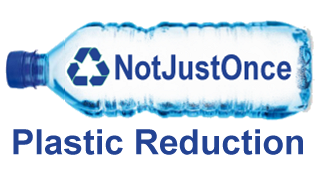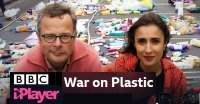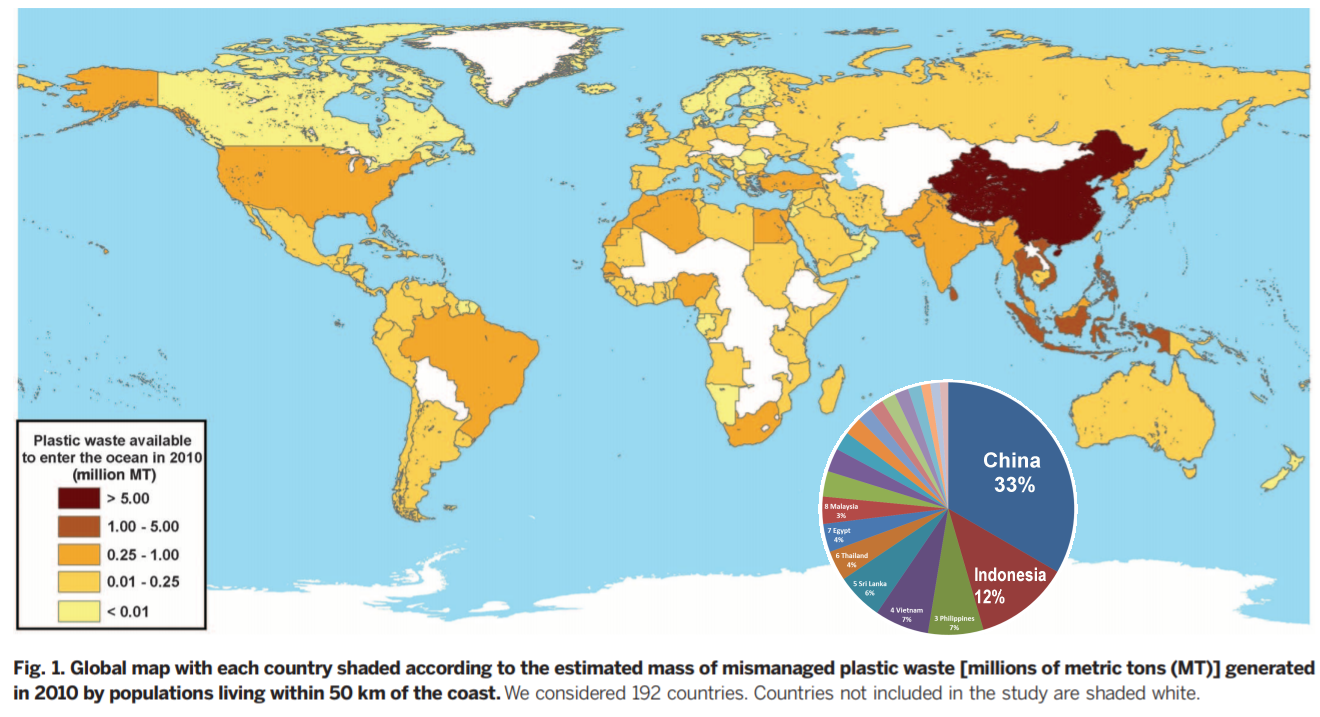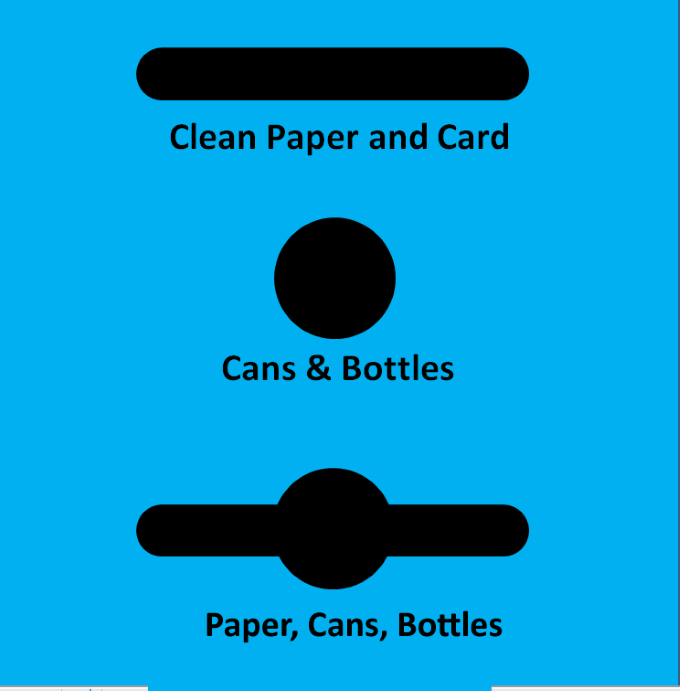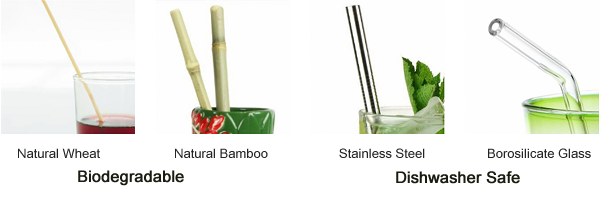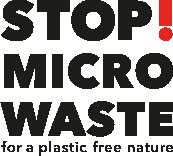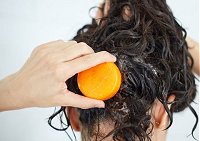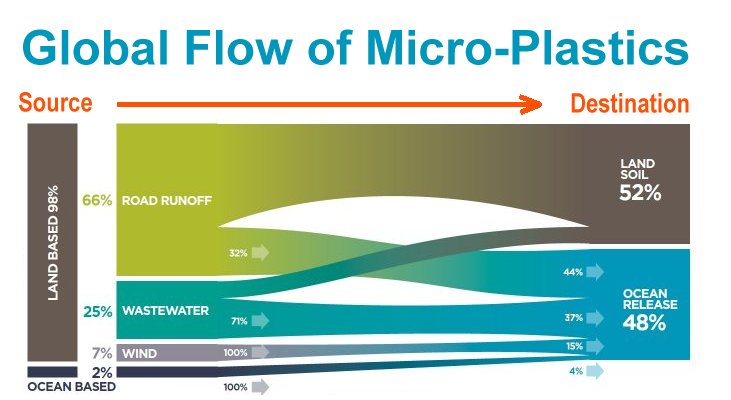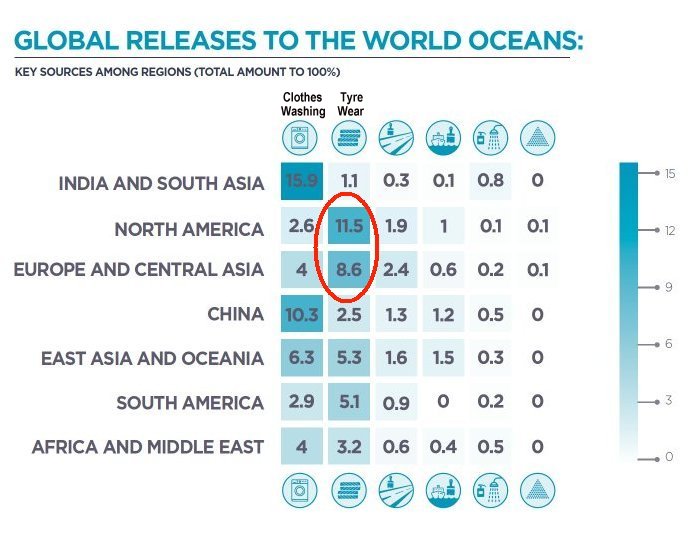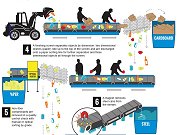Feedback: enquiry@notjustonce.org
Plastic Pollution Reduction in Macclesfield?
David Attenborough's Blue Planet II was shocking, and together with Drowning in Plastic, left us wondering what we as individuals could do to reduce the problem?
This website aims to answer that question, offering a menu of nine simple strategies.
Macclesfield is a long way inland and, like most developed western countries, most of our waste is well managed and doesn't find its way into the sea - apart from litter that gets into the drains and rivers, and plastic items flushed down the toilet.
But if we consider only
micro-plastics, (pieces smaller than 5mm) western developed countries have more work to do, being
the largest contributor to micro-fibres from washing machines and micro-plastics from road run off.
30% of fish caught in our
UK coastal waters contain traces of micro-plastic.
What Can We Do?
Lots of the big changes, such as the proposed deposit scheme on bottles and cans, are being made by government and trade associations, but this website suggests ways you as an individual can make a difference - by your own actions, and by influencing others.
If we reduce the number of single-use items sold to the public, we reduce the 'opportunities' to discard them as litter.
But the idea of a simple 'War on Plastic' risks throwing out the baby with the bath water. Durable plastic products have served us well in many aspects of daily life - from near-indestructible toys, to reducing the weight of our cars, making them more fuel efficient and safer.
Our focus should be a 'War on
Single-use
Plastic and Litter'
Menu: Choose from these Topics
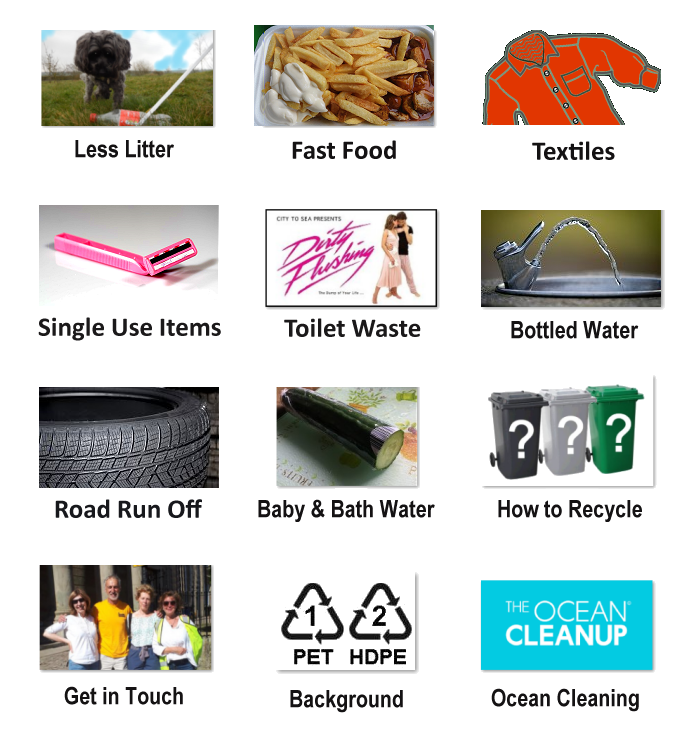
The key to ocean pollution by items bigger than 5mm, lies in understanding and reducing litter and fly-tipping. Plastic items put into a bin, (any bin - recycling or not), will be managed properly, and won't find their way into drains or rivers.
Previously, this litter has seemed mainly a cosmetic issue; but now we are aware of real casualties from this problem.
Britain is not a major contributor to ocean
plastics derived from mis-managed waste. In 2015, the journal 'Science' estimated 84% comes from 20 countries, mostly in Asia.
In contrast, if all of coastal Europe was combined we would rank only 18th.
more
Fortunately, Blue Planet II struck a chord in
China; reportedly the internet was slowed when around 80 million people
watched the second episode. Theresa May (rather pointedly) gave
president Xi Jinping the box set when they met in February 2018.
What Can be Done about Litter?
If an area is clean, no-one can claim their new litter makes no difference.
-
Pick up a few bits of litter each day when you walk the street or your local park.
Every little helps. Clean areas attract less litter. By being seen to clean up, you will encourage others to clean up too, and you promote the idea that litter is not OK .
-
Help fill in some blanks on our map of litter-picked areas of Macclesfield:
Visit the website and the Facebook Group -
Dog walkers tend to have preferred routes, and could easily 'maintain' them -
and improve the environmental image of dog walkers at the same time. -
 When you are at the seaside,
pick up a few items of litter.
When you are at the seaside,
pick up a few items of litter.
See the 2 minute beach clean video
-
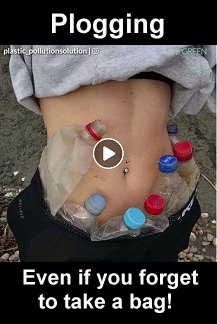 Runners in Sweden are encouraged to try
Plogging
(collecting rubbish as you run).
Runners in Sweden are encouraged to try
Plogging
(collecting rubbish as you run).
-
-
Ask your council for more litter bins in the street, and maybe try one of these Top 7 Anti-Litter Campaigns .
The successful Keep Britain Tidy 'Bin it for Good' scheme rewards bin use with charitable donations.Read more about litter bin design and placement
here
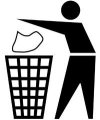
-
Publicise the effect of litter on marine life.
Download and print these A4 posters.
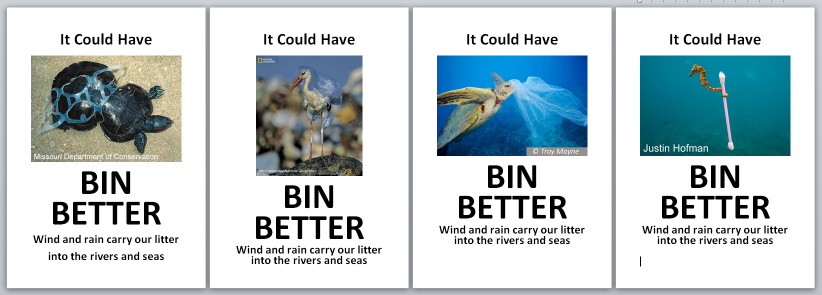
or these:-
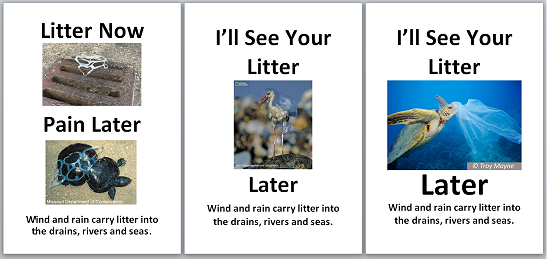
-
Appeal to local pride, and engage community action.
Encourage residents to clean up (and maintain) their neighbourhoods. Find your neighbourhood group.
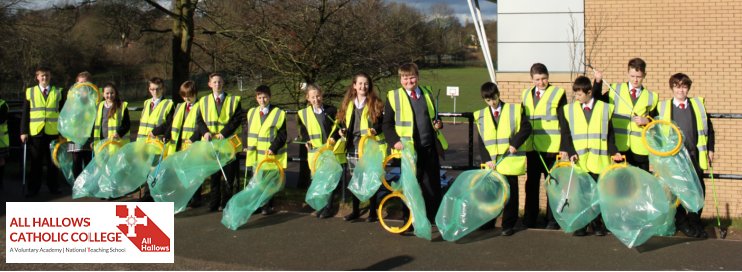
The Don't Mess With Texas campaign harnessed local pride and endorsements by celebrities to target 18 - 34 year-old males, and was credited with reducing Texas highway litter by about 70%.
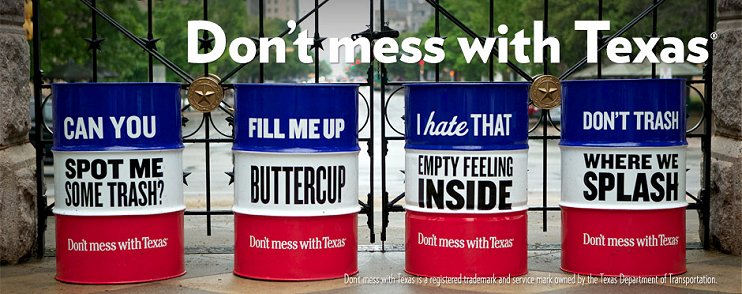
-
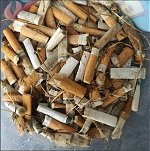 Disposable Nappies add
to plastic use, but tumble-dried reusable nappies have a higher
carbon footprint. Use a clothes line to dry them when possible!
Disposable Nappies add
to plastic use, but tumble-dried reusable nappies have a higher
carbon footprint. Use a clothes line to dry them when possible! -
Cigarette Ends, made from cellulose acetate, are the world's most common item of litter. They take 10 years or so to degrade, and travel from street gutters via drains, and rivers to the sea, where they are picked up by birds. These 500 butts were collected in one beach clean.
-
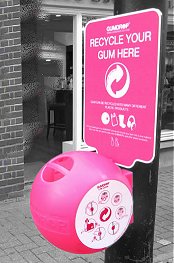
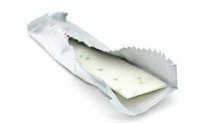 Chewing Gum is the
world's second most common item of litter. These
paper wrappers can be re-used to prevent discarded gum sticking
to everything - an 'advantage' not offered by sugar-coated
tablets of gum.
Chewing Gum is the
world's second most common item of litter. These
paper wrappers can be re-used to prevent discarded gum sticking
to everything - an 'advantage' not offered by sugar-coated
tablets of gum.
Better still, find a Gumdrop, gum recycling point, and have your gum made into something useful. more
-
Apply the new £150 fines for littering. Small fines, rarely applied, trivialise the problem. Large fines that are aapplied, send a signal 'Litter is Damaging'.
-
Introduce the deposit scheme on plastic bottles.
-
The UK uses a staggering 38.5 million single-use plastic bottles every day, of which more than 40% are not recycled.
-
In addition to encouraging people to recycle their own bottles and cans,
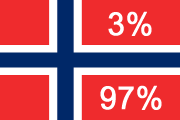 The deposit scheme
will encourage people to pick up littered bottles to claim
the deposit (as
in Germany) - before
they get into the sea .
The deposit scheme
will encourage people to pick up littered bottles to claim
the deposit (as
in Germany) - before
they get into the sea . -
Research shows deposit schemes work:
In Norway, recycling rates are at 97%.
(That's only 3% not recycled, compared with our 40%).
Watch the BBC Video about Norway's scheme -
In some parts, of the UK 37% of children drink bottled water rather than tap water (!)
-
That said, clear plastic PET drinks bottles sink in water (if the tops are removed) but translucent milk bottles and other opaque bottles float, with or without their tops. See plastic types
-
Although PET bottles sink, the bottle tops float - and appear to be a tasty morsel to sea birds and larger fish. So there are suggestions that the tops should be somehow made captive on the bottle - such as flip-tops.
-
-
Why does Litter Persist? Keep Britain Tidy published a paper on their website 'Using behavioural science to reduce littering: Understanding, addressing and solving the problem of litter' .
The main points are summarised here.-
The full document is a fairly heavy read, but has been distilled down to an 11 page (!) document, highlighting what were the most useful paragraphs, or you can read the full document here
-
-
Coffee Cups: Each year in the UK, fewer than 1% of the 2.5 billion paper coffee cups used are recycled.
-
Take a re-usable (insulated?) mug for your coffee purchases, and get a discount.
-
Reducing the base price and charging a 25p surcharge for the disposable cup, giving the same net price, worked better in a trial at Winchester University. It seems we hate a surcharge more than we love a discount.
-
Coffee Cups CAN be recycled in Cheshire East. Tear the cup, breaking the wax seal and allowing the chemicals used in paper making to 'get under the skin', and put it in a Silver Bin.
-
Cafes serving single-use plates, cups and cutlery
Ask them to change, or at least use compostable equivalents. Many of these items are heavily contaminated with surplus food, so it makes sense if they can be composted together - not in domestic compost heaps (not hot enough), but in commercial in-vessel composters, such as Cheshire East now has.Compostable container prices are now only 5p - 10p more than styrofoam.
-
Take Away Food
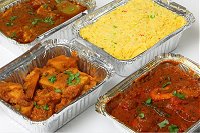
-
Ask your local take-away why they use plastic trays rather than aluminium foil or compostable bagasse?
Show them this list of alternative suppliers. -
Why use plastic cutlery rather than wood? Can they at least offer their customers a choice?
-
-
Plastic straws are not recyclable
McDonalds announced that they would switch their 1.8 million plastic straws per day to paper in September 2018.-
Support the proposed ban on plastic straws and plastic cotton buds
-
Sign the petition to ban plastic straws here.
-
-
The fashion industry is the world's second largest polluter - after oil and gas. The colouring dyes used in cotton production pollute water courses - as detailed in Stacey Dooley's 'Fashion's Dirty Secrets' .
-
Cotton growing also accounts for 7% of pesticides used in the USA.
-
Wool, on the other hand, seems quite sustainable - apart from sheep burping greenhouse gases.
-
Polyester Fleece is thought to be one of the biggest emitters of micro-fibres due to its construction. An alternative is woollen fleece.
-
Acrylic fabrics, (mostly sweaters, socks, and fleeces) are the worst, shedding about 50% more fibres than polyester fabrics.
-
Recycled fabrics - including cotton and polyester - use less resources. e.g. Inland Sea products
-
Which fibre types are the most sustainable?
-
The 'Good On You' website offers more information about the sustainability of different fabrics here

-
Buy Fewer New Items: It is claimed that 60% of clothing is discarded within a year. About half of what we buy use natural fibres such as cotton and wool; a third is synthetic; and about 10% is made from viscose/rayon (derived from wood cellulose - i.e. tree felling).
-
Keep Clothes for Longer. Think twice before replacing a serviceable garment with a new one.
This reduces your consumption of resources. -
Cherish the clothes you have. Buy better quality to last longer. Let fashion changes pass you by.
-
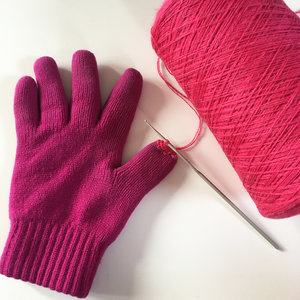 Learn How to Mend
Clothes:
For example
The Tailoring Academy
on Pickford street run
drop-in sewing classes.
Learn How to Mend
Clothes:
For example
The Tailoring Academy
on Pickford street run
drop-in sewing classes.
Patagonia offer tips on maintaining clothing .
Collingwood-Norris show how to mend knitted gloves
and Love Your Clothes have tips on Invisible and visible mending
-
Don't buy new: The first washes of a new garment release significantly more fibres than subsequent washes. Check out your local charity shops or clothes up-cyclers before buying new - and maybe get a designer label at a good price?
-
When You're Done With Them, don't throw them away.
-
Charity shops accept worn and dirty clothes - not just the most saleable items. If they can't sell them in the shop, they go to a specialist textile recycler who makes use of the fibres. Sainsburys Report
-
In addition to the charity shops Marks & Spencers have in store collection points, and reGAIN have an app that enables used clothes to be exchanged for discount vouchers on new clothes.
-
-
Fabric Washing is the major source (35%) of micro-fibres in the ocean, with a typical 5kg wash load of polyester fabrics producing six million micro-fibres.

Water treatment filter plants around the country can remove 65 - 90% of textile fibre fragments from waste water, but they are then contained within the (mostly organic) sludge residue, that is either applied to the land as fertiliser, or dumped at sea(!). We need to ask how that can be improved?
-
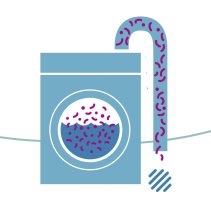 Wash Less Often: At home, an obvious first move is to consider whether
you are washing more often than necessary? How often do you really need to wash clothes, towels, bed linen?
There is a potential saving of water, and energy used too.
Wash Less Often: At home, an obvious first move is to consider whether
you are washing more often than necessary? How often do you really need to wash clothes, towels, bed linen?
There is a potential saving of water, and energy used too. -
Wash Programme Selection: Shorter, gentler, wash programmes with lower temperatures release fewer fibres.
-
Wait until you have a full load for your machine; the clothes move around less, and break off fewer fibres.
-
Detergent: Liquid is less abrasive to fibres than powder, and you can offset the disadvantage of its plastic container by using a refill service such as Ecover - currently being trialled by Inland Sea at the monthly Treacle Market
-
Tumble drying is best avoided as it beats the fabric, making fibre damage more likely. If you can dry your clothes on an indoor airer or outdoor clothes line, that risk is minimised - and you save energy too.
If your machine has a lint filter, don't clean it out by washing the lint down the drain; put it in a bin. -
Fibre Capture: Until washing machines are equipped with outlet water filters, the only options available are a few products which aim to retain some of the micro-fibres inside the drum:-
-
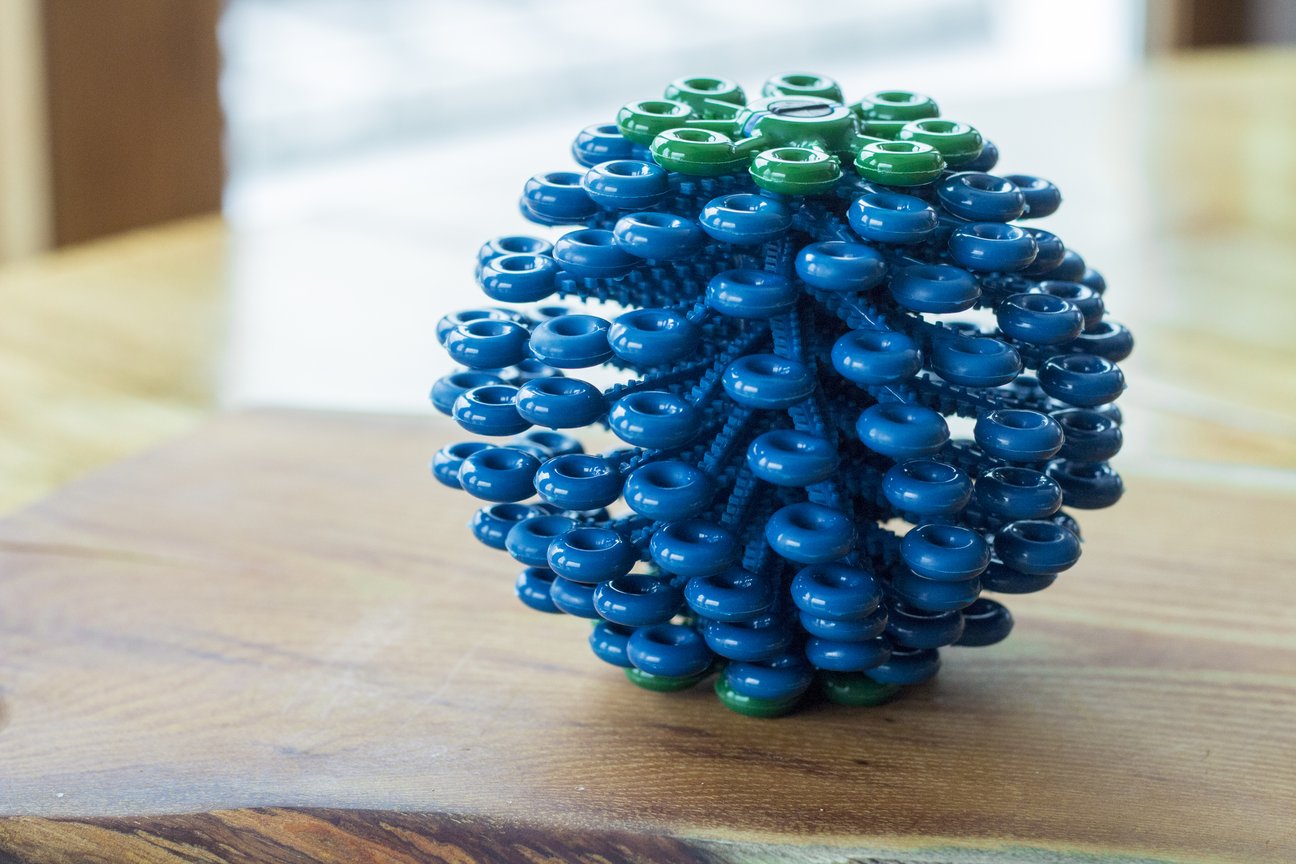 Coraball
£30
Coraball
£30
A 10cm diameter recycled plastic ball, which claims to retain 25-33% of fibres in every wash.
You pick them out of the ball when they have accumulated.
More Information
-
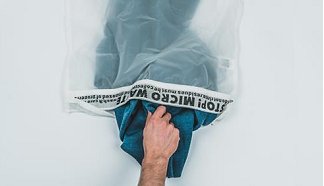 GuppyFriend
£25
GuppyFriend
£25
Claimed retention of around 80% of fibres.
The fibres accumulate in the corners of the bag, where you can pluck them out and bin them.
More Information
-
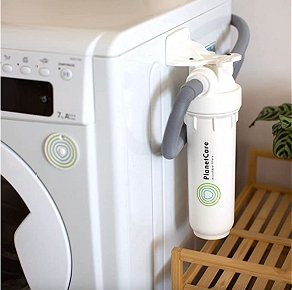 Planetcare
have sold 10,000 outlet water filters
with claimed 90% efficiency, for about £75.
More Information
Planetcare
have sold 10,000 outlet water filters
with claimed 90% efficiency, for about £75.
More InformationAEG also now have a product retailing for £80 which uses a reuseable fine mesh filter, and Bosch have another product that also does not use disposable filters but costs £199.
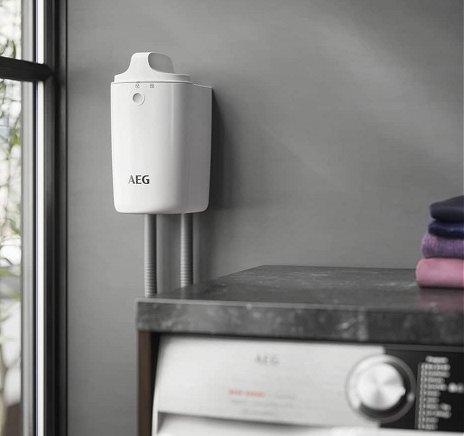
Finally Cleaner Seas have a filter which uses a reel of filter paper that is electrically advanced when it becomes loaded. The filter costs £130 and cartridges (more than 100 washes) £15.

-
-
More Information about Textiles
-
HUBBUB offers good tips on extending the life of your clothes
-
Help With The Washing have a good overview of the problem and some solutions here
-
Parliamentary sub-committee report on Micro plastic prevention and solutions
-
BBC News article
-
Technical Background Document here
-
Disposable? Think twice about buying anything with the word 'Disposable' in the description.
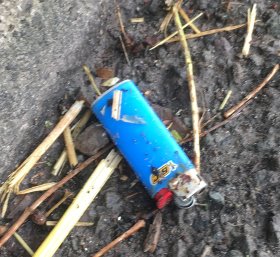
-
Lighters - Use matches or a refillable lighter.
-
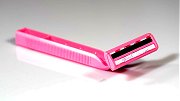 Razors - The combination of steel and plastic cannot be
recycled. Use an electric razor, or a safety razor with replaceable
blades. see
the video .
Razors - The combination of steel and plastic cannot be
recycled. Use an electric razor, or a safety razor with replaceable
blades. see
the video . -
Cutlery - Keep a set of travel cutlery with you at work or in your bag to avoid plastic cutlery.
-
-
Buy your Milk in Glass Bottles - delivered to your door
-
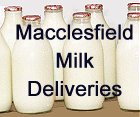 Newton's Dairy, Trevors Close Farm, Dark La, Macclesfield SK11 9QZ.
Phone: 01625 423987
Newton's Dairy, Trevors Close Farm, Dark La, Macclesfield SK11 9QZ.
Phone: 01625 423987 -
Smiths Dairies, Queens Avenue, Macclesfield SK10 2BN, Phone: 01625 616178 Website
-
John Evans of Marple, for Prestbury and Bollington 01663 741108
-
-
Or buy Milk in Big Plastic Bottles; a 4pint bottle will stay fresh for a week in the fridge, and uses half the plastic of four 1pint bottles.
-
Buy only loose tea or bio-degradable tea bags such as Twining's 'Loose Leaf' pyramid tea bags, Pukka Herbs, Aldi's premium Specially Selected range, Yorkshire Gold, and Waitrose's Duchy range. more
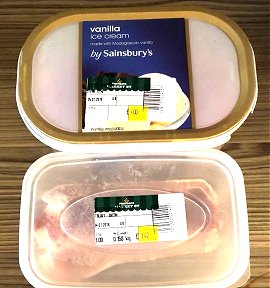
-
Take a plastic storage box (preferably re-using an ice-cream tub or similar) to the butcher or fishmonger, so they don't need to wrap it for you? Morrisons put their checkout barcode sticker on your container, so you can just scan it like any other item. You also get 100 loyalty points worth 10p.
-
Avoid food sold on Black Plastic Trays. Recycling scanners generally can't 'see' black plastic items. Buy food sold on lighter coloured trays, it will help motivate the suppliers to change.
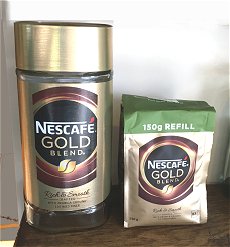
-
Buy refills for glass jars (e.g. spices, coffee), liquid hand soaps, wipes.
-
Shops that still offer free plastic bags; ask them to stop proffering them, and provide only when asked. (Make an end to "Would you like a bag for that?" ). Show them this list of alternative bag suppliers.
-
Instead of Cling Film, save food left-overs in old ice-cream tubs. But don't fret about cling film; recycling a single 4-pint milk bottle, saves as much plastic as 10 metres of cling film.
-
Buy Shampoo Bars instead of bottles.
e.g. Lush . The Independent's review of shampoo bars . -
Disposable Nappies add to plastic use, but tumble-dried reusable nappies have a higher carbon footprint. Use a clothes line to dry them when possible!
-
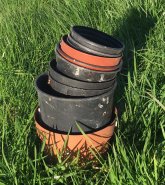 Plant Pots. The 500
million
plastic pots we use in the UK each year, generally contain up to 98% recycled plastic, so
they have been round the system once already, but black plastic
cannot be 'seen' by most recycling systems, and ends up being
burned for energy recovery.
Plant Pots. The 500
million
plastic pots we use in the UK each year, generally contain up to 98% recycled plastic, so
they have been round the system once already, but black plastic
cannot be 'seen' by most recycling systems, and ends up being
burned for energy recovery.
A new recyclable taupe (grey) pot has been trialed, and some local authorities (not Cheshire East) do accept non-black pots.
Starting in 2026, all non-black, recyclable PET or PP plastic plant pots will be accepted in household kerbside recycling in England. more
B&Q have started accepting used plant pots for recycling.
The Horticultural Trade Association is offering garden centres advice on plastic recycling. -
Extend the ban on micro beads. more
-
Impose a tax on single-use plastic items - bottles, cutlery, straws, take-away food containers?
(Is it true that most plastic-bottled drinks are either sugary, or pointless - like still water?) -
Toilets are for Pee, Poo, and Paper.
-
Get a bin in your bathroom for wipes, tampons, condoms, plasters, dental floss, cigarette ends, etc.
-
Wet Wipes: Switch to bio-degradable, not just 'flushable'.
e.g. Waitrose, Boots and Andrex. (The labelling is sometimes confusing, with the wrapper itself marked as non-recyclable plastic).
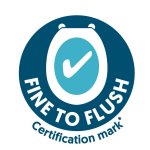
Only products carrying this logo
are truly 'fine to flush'.
Details
-
Use bio-degradable cotton buds (without plastic sticks) more info
-
Contact Lenses: Don't flush them; Boots will recycle any brand for you. More info
-
See the videos produced by City to Sea and their Facebook page
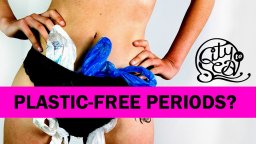
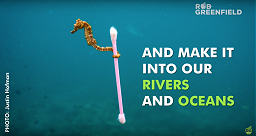

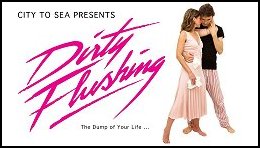
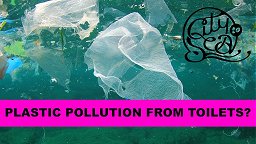
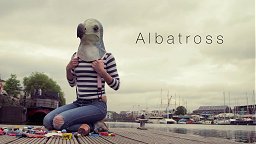
-
Surfers Against Sewage
 have a
Plastic
Free Coastlines campaign and downloadable starter pack.
have a
Plastic
Free Coastlines campaign and downloadable starter pack.
-
Can you engage with your local water company? It's in their interest to reduce filter blockages.


-
Make public water fountains available to re-fill bottles?
-
Ask your council and local employers to install them.
-
-
Persuade more local business owners to offer free refills and join the Refill scheme. (See the map right).
-
Download the App from Refill.org.uk to locate free water near you.
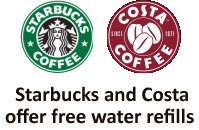
-
Dispel the Myth that plastic water bottles are dangerous to re-fill.
See the BBC video clip. (Want to know the source of the myth?)
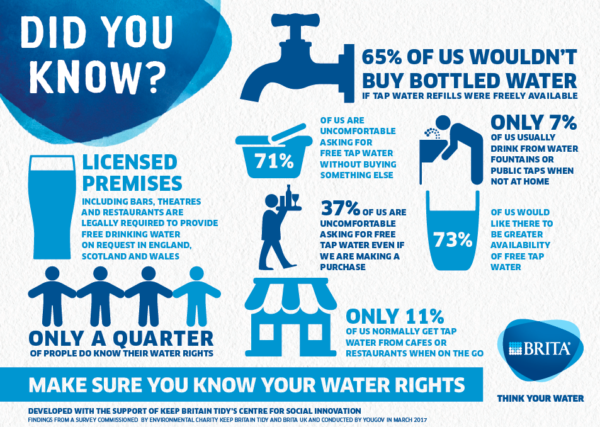
-
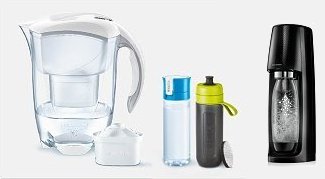 If the
Taste of tap water makes
you buy bottled water:-
If the
Taste of tap water makes
you buy bottled water:--
Try using a filter jug at home or a filter bottle on the go.
-
If you like Sparkling Water, consider buying a SodaStream with reusable bottles.
-
Buy your water in glass bottles from Wilboarclough's Crag Spring Water company. more
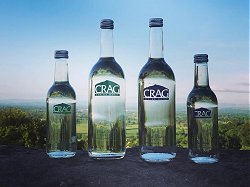
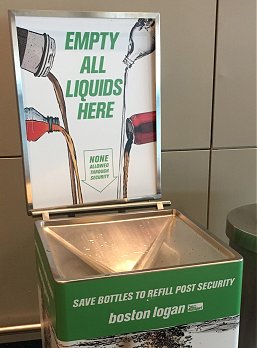
-
-
Airports: Look out for more airports that make it easy for you to empty your water bottle and then refill it after passing through security. See a list www.wateratairports.com
Manchester Airport now makes it clear that you can take an empty bottle through security, and refill it at one of 19 free water fountains, or get a free refill at any of the bars, cafes, and restaurants. Details -
What can you do? Apart from raising awareness of this problem, there is not much an individual can do, apart from choosing tyres that claim longer life, and driving as you would to save fuel.
-
Check tyre pressures
-
Don't carry excess weight or a roof rack.
-
Accelerate, steer and brake gently.
-
Walk, cycle, car share or use public transport.
-
-
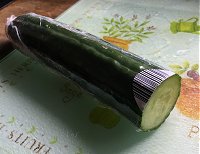 Plastic wrapping around a cucumber
trebles its
fridge-life, and reduces food waste - a source of methane
gas in landfill.
Plastic wrapping around a cucumber
trebles its
fridge-life, and reduces food waste - a source of methane
gas in landfill. -
MAP - Modified Atmosphere Packaging: Some of the apparently pointless sealed plastic bags around foodstuffs, contain a gas such as nitrogen or carbon dioxide that extends the shelf life and reduces food waste. more
-
Replace plastic bags for fruit and veg with paper bags?
This good for plastic pollution, (If a paper bag escapes into the environment it biodegrades very quickly, whereas a plastic bag degrades hardly at all), but The Environment Agency have calculated that paper bags are worse for global warming - unless they are used four or more times, but that was unlikely to happen, due to the poor durability of paper bags - particularly if they become wet from leaks or condensation on chilled food items.
On the same basis, you have to use a heavy-duty plastic 'bag for life' five times; a polypropylene bag 14 times; and a cotton bag 173 times. more -
Glass bottles are heavy to transport, and more liable to break into dangerously sharp pieces.
If you want to be able to squeeze or see the contents of a container, there are almost no alternatives to plastic. -
Plastic packaging (padding and foam) prevents damage to goods in transit - another source of waste.
-
Unlike metal, plastic items don't rust or need (toxic?) paint coatings.
-
Don't replace durable plastic items with 'greener' equivalents; plastic disposal is what we seek to avoid.
-
Do not burn plastic - it needs 2 seconds above 850 deg. C to avoid producing toxic dioxins.
This can only be done in commercial incinerators. -
Description of the previous sorting process at UPM Shotton here .
-
Watch the Video of how silver bin material is sorted at Biffa here
-
If you want to know more: Follow the guidance on Cheshire East's website
and on their flyer .
They describe both the most ecological and economical way to dispose of each material. (and it avoids having your bin rejected at the kerbside.)
This advice aims to strike a difficult balance between simplicity, and completeness; High Peak Borough Council use the same recycling company, and some people prefer High Peak's advice for recycling plastics in their brown(!) bins. -
Use the Recycling Codes moulded into plastic items to avoid uncertainty about what to do with "Hard Plastics".
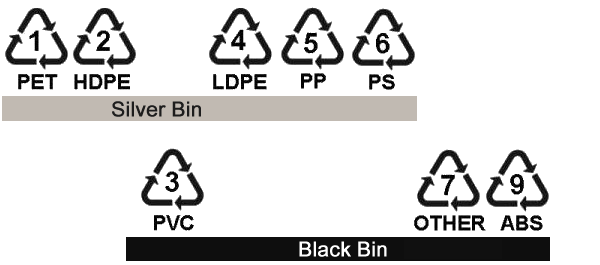
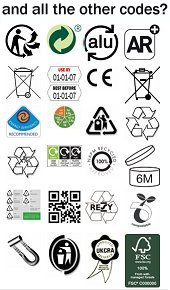
Unfortunately, there is currently no market for some recycled plastic grades; they end up being burned for energy recovery. -
If in doubt, put items in the black bin, or call 0300 123 5011 for advice.
-
Bottle tops are best left on the bottle, so they don't fall by the wayside in the journey to the recycling plant. It also stops contamination (broken glass etc.) getting inside the bottle.
-
Rinse. You don't need to be too fussy about washing your recycling, but a quick rinse will stop it becoming smelly. Do avoid leaving much food in containers - so that it doesn't leak onto paper in the same bin, and make that un-recyclable.
-
Coffee Cups CAN be recycled in Cheshire East. You must tear the cup, breaking the wax seal and allowing the chemicals used in paper making to 'get under the skin'.
-
Cling film should go in your black bin - it is generally too contaminated, and represents very little plastic.
Ten metres of cling film represents the same mass of plastic as one 4-pint milk bottle. -
Clear Plastic Film, 'Cellophane', and Polythene: If it makes a crinkley sound when handled, and tears rather than stretches, put it in the black bin.
If it makes no noise, and stretches before it tears, its probably polyethylene and should go in the silver bin.
(Technically, uncoated cellophane can be composted, but it is often coated - which slows the process - and it is so difficult to correctly identify, that it is safer to put it in the black bin). -
Plant Pots: can be returned to B&Q for recycling.
-
Plastic bags go into the Silver bin. The film usually comprises several layers of different polymers that are impossible to separate, but it is used to make black bin bags.
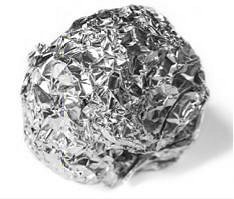
-
Aluminium Foil needs to be reasonably clean, not perfect.
Larger pieces are best scrunched up into a ball the size of a tennis ball.
The reason for this, is that aluminium cans are repelled from the conveyor belt by an eddy current system, and leafy pieces of foil flutter aimlessly instead of following the same trajectory as aluminium cans.
Watch an eddy current separator at work .
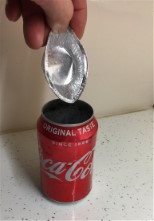
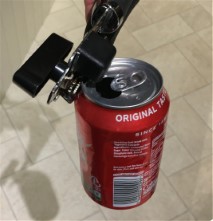 Steel
items fall steeply off the second roller, while
aluminium is repelled forward into the collection box.
Steel
items fall steeply off the second roller, while
aluminium is repelled forward into the collection box.
Foil bottle tops, and smaller pieces of foil can be squashed into an aluminium drinks can over several days, and retained with a piece of tape if necessary when full.
-
No Nappies Please: They have to be removed from the process by hand....................
-
Books generally contain too much glue in the binding for making into new paper, but telephone directories contain so much paper they are acceptable. Books are a mixed blessing to charity shops. Some books can be sold for 50p-£1; The Ziffit App uses your phone to scan barcodes and give an instant value to some books; Everything else goes to World of Books earning the charity only 2.5p per kg. (that's 0.6p for a paper back, or 3p for a coffee table book).
-
Clothes, Textiles and Shoes are not recycled from the wheelie bin collection, but you can take them to banks at various locations:- London Road Co-op, Duke Street Car Park, Tesco Hibel Road, Sainsbury's, Westminster Road Shops. H&M have now started a clothes recycling scheme.
-
 Terracycle
is an interesting complement to council recycling schemes
accommodating materials that are generally not economically
recyclable.
Terracycle
is an interesting complement to council recycling schemes
accommodating materials that are generally not economically
recyclable.
Volunteers collect items, sorting them by type, so that 'pure' bags of each product type can be presented for recycling. In return, Terracycle makes a donation to a charity of the collector's choice, and the cost of recycling is subsidised by one of the manufacturers of that type of product. More Info -
Arrange a Free Talk or workshop by Ansa for your community group or school.
-
Don't Bin it; Donate it.
-
Try a local Charity Shop. Small plastic toys, clothes, and bric-a-brac are well received.
-
Local Groups such as Freecycle or MaccRecycle will generally put you in touch with someone who wants your item and will collect them within hours.
-
Textiles and footwear recycling bins are to be found outside corner shops and supermarkets
-
-
Scrap Metal: The silver bin can accept only cans, but Henshaws will buy quite small quantities of scrap metal, car batteries etc. For example copper is bought for about £1.50 per kg. Aluminium 40p, Lead 65p, Car Batteries 30p (about £4 -£6 per battery).
-
Psychology: The Viridor Recycling Report 2017 found the reasons people DO recycle were-
-
If you are interested in plastic pollution, or the broader issue of Sustainability in Macclesfield, Macctastic has set up six working groups interested in Litter Picking, Helping small retailers to recycle more, Plastic Reduction, Pollinators, a Repair Cafe, Tool sharing, and Transport.
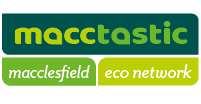
For more information visit www.macctastic.org or the Facebook Group.
Contact: admin@macctastic.org -
Find the community group for your neighbourhood. here
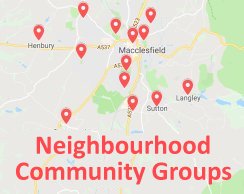
-
Transition Bollington's Facebook Page and website .
-
Transition Wilmslow's 'Plastic-Free Town' website and Facebook Page
-
Transition Buxton's website and Facebook Page
-
Rethink Plastic New Mills Web page
-
Feedback on this website enquiry@notjustonce.org .
-
Try this mind Map; one of several from Learning Fundamentals in Australia
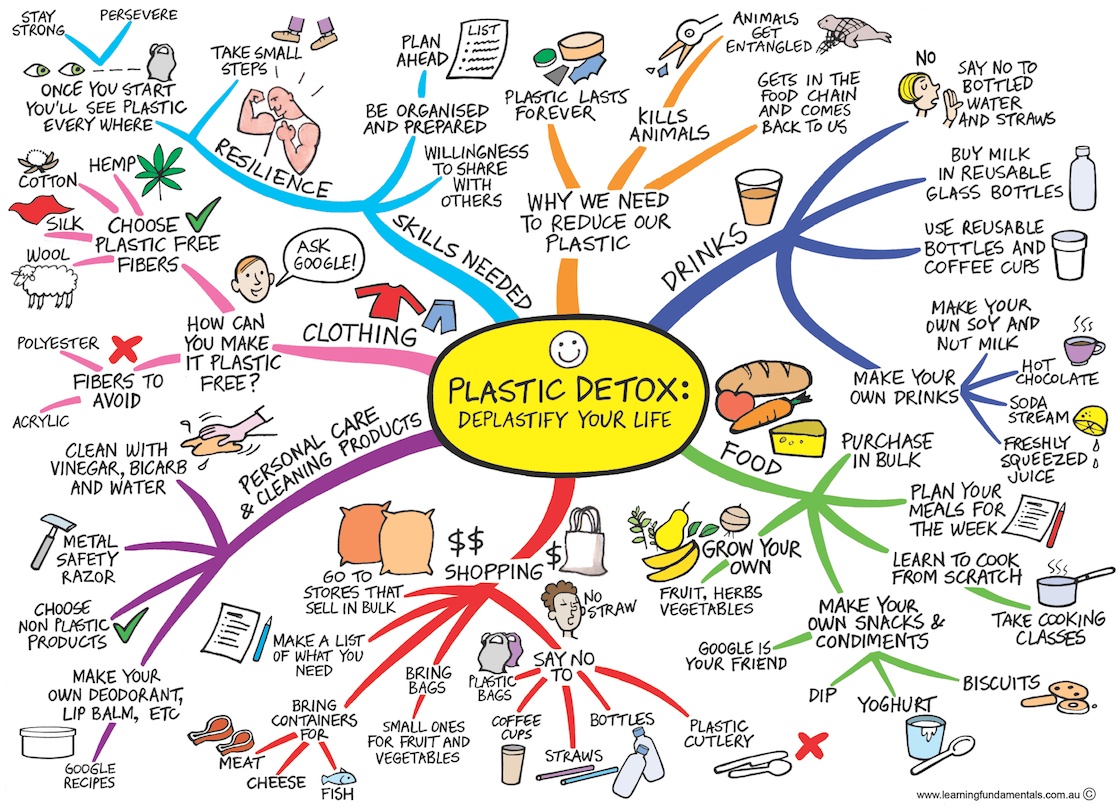
-
Publicity: Some big guns are being brought to bear on this problem.
-
Sky have an Ocean Rescue page
-
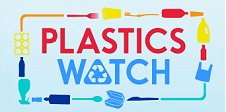 The
BBC has
a dedicated page explaining the plastic problem a separate
Plastics Watch Section.
The
BBC has
a dedicated page explaining the plastic problem a separate
Plastics Watch Section.
and a series of three iPlayer Radio talks about the origins of our plastic use, and the solution.
-
-
What are Supermarkets doing to help? BBC article
-
Learn more about the proposed (New) Circular Plastics Economy/Commitment , INCPEN (The Industry Council for research on Packaging and the Environment) and WRAP (The Waste and Resources Action Programme)
-
The Guardian: Michael Gove on Recycling
-
Plastic Types
Plastic is not one material, but a family of many different types.
The amber coloured cells below show those that float in water.
The green cells on the right show the only grades that have a recycling value.
Note that coloured material is worth less. (If you must buy a drink in a PET bottle try to avoid strongly coloured bottles.)
The lower value grades tend to be burned for energy recovery.
-
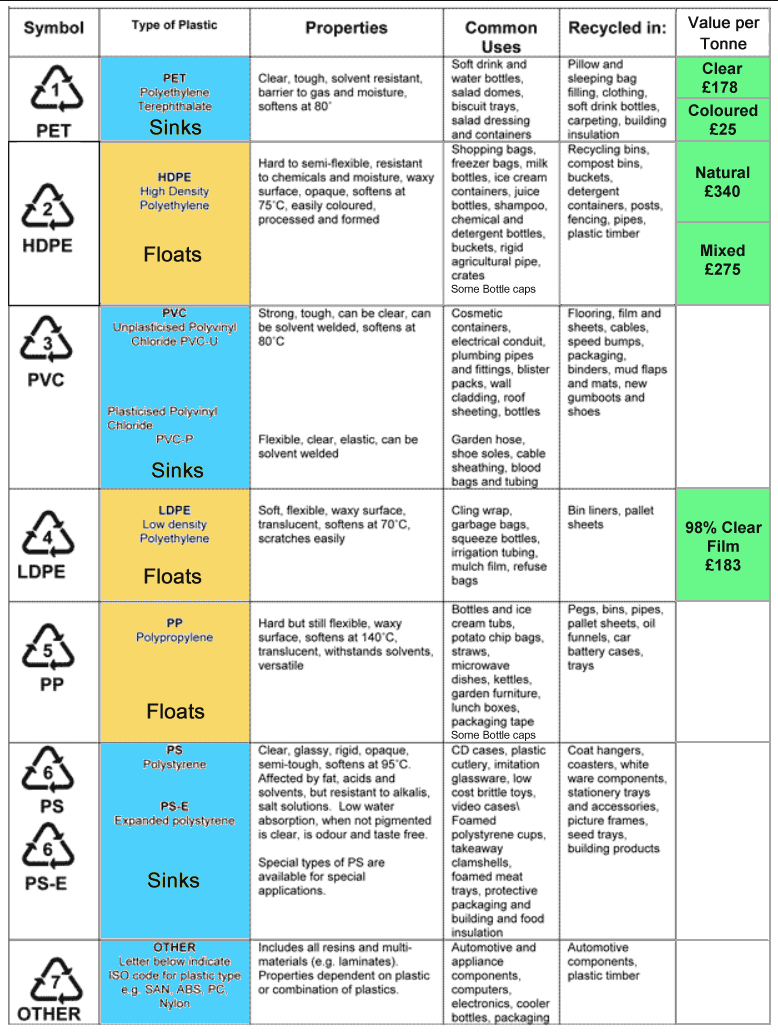
-
Bio Plastic: Generally plastic made from plant material such as cellulose or starch. Includes PLA, Bagasse, and BioPBS.
Vegware have a good page detailing these materials
Some have the same properties as plastic made from oil, (i.e. not easier to recycle) and there is concern that it could take land away from food growing. Only about 40% is bio-degradable, and composting often requires higher temperatures than are found in home compost heaps.
(See Composting below.) -
Bio-degradable Plastic: Another mixed blessing; can degrade into small plastic particles that are particularly undesirable in sea water, and (because it degrades) if it is put in with recycling, it reduces the quality of the recycled plastic (!).
-
 Compostable,
Industrial: Bio-degradable plastics can be
composted, but generally do not bio-degrade in domestic
compost heaps or in the natural environment - they need the
higher temperatures found in an 'In Vessel Composter' such as
the one
Cheshire East have at Crewe .
Compostable,
Industrial: Bio-degradable plastics can be
composted, but generally do not bio-degrade in domestic
compost heaps or in the natural environment - they need the
higher temperatures found in an 'In Vessel Composter' such as
the one
Cheshire East have at Crewe .
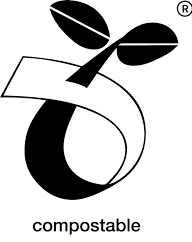
This opens the opportunity to process food waste mixed with biodegradable cutlery and plates - a big recycling problem for the catering trade. Vegware, producer of plant based catering supplies, have a good page on Compostable Materials -
 Compostable, Home:
Some lightweight films used in plastic
bags and wrappers are approved for composting at home. They
tend to be made from starches such as potato, and break down
at lower temperatures.
Compostable, Home:
Some lightweight films used in plastic
bags and wrappers are approved for composting at home. They
tend to be made from starches such as potato, and break down
at lower temperatures. -
Micro-plastics are pieces smaller than 5mm in diameter. Primary micro-plastics are pieces that were made that small when new (such as fibres); secondary micro-plastics are the result of erosion of larger pieces.
-
PCR - Post Consumer Recycled Plastics: Using old plastic items to make new plastic is key to the Circular Economy.
-
Wikipedia has a good section on Plastics. It is detailed but well structured, making it easy to skip to what you want to know.
-
BBC guide to identifying plastics here
-
SLOactive have an informative webpage on the facets of plastic pollution.
-
See the Viridor Report on UK Recycling 2017 . Key findings:-
-
Nearly two-thirds (63%) of consumers were frustrated that different councils collect waste in different ways.
-
Three-quarters (73%) of the UK public said they would like more transparency on what happens to their waste.
-
Only half (49%) were very confident they put different waste in the right bins.
-
-
Plastic Facts published by the Association of Plastics Manufacturers.
-
40% of plastic goes into packaging. Only 4 to 6% of all the oil and gas used in Europe is employed in the production of plastic materials. (in Asia where 50% of plastic is made, it may be more).
-
Across Europe, of all the plastic waste that is collected 30% is recycled, 30% goes to landfill, and 40% is burned to recover energy.
-
-
What are the Gyres, what's in them, and why not just clean them up?
-
Micro plastics are pieces less than 5mm in length, mostly broken down fragments of larger items, that tend to float below the surface, turning the sea to soup.
-
theOCEANCLEANUP. is a project to put slow-moving booms in the gyres to gather the drifting plastic for easy harvesting.
-
A report published in Nature, March 2018 , states that in the Great Pacific Garbage Patch gyre, over three-quarters of the plastic mass was carried by debris larger than 5 cm and at least 46% was comprised of fishing nets. Micro plastics accounted for 8% of the total mass, but 94% of the estimated 1.8 (1.1–3.6) trillion pieces floating in the area.
-
 The
Ellen MacArthur Foundation was launched in 2010 to accelerate the transition to a circular economy.
Since its creation the charity has emerged as a global thought leader, establishing the circular economy on the agenda of decision makers across business, government and academia.
The
Ellen MacArthur Foundation was launched in 2010 to accelerate the transition to a circular economy.
Since its creation the charity has emerged as a global thought leader, establishing the circular economy on the agenda of decision makers across business, government and academia.
Fast Food
Textiles
As with many aspects of sustainability, textiles is a subject full of trade-offs. Synthetic materials such as Nylon, Polyester, and Acrylic, use very little water in production, but consume fossil resources, and their laundering releases millions of micro-fibres into water courses.
 Cotton, in contrast, is a natural fibre, but uses
large amounts of water in processing. (It takes
about 8,000 litres for a pair of cotton jeans -
though over half of all cotton is rain-fed rather than irrigated).
Cotton, in contrast, is a natural fibre, but uses
large amounts of water in processing. (It takes
about 8,000 litres for a pair of cotton jeans -
though over half of all cotton is rain-fed rather than irrigated).
What could you do?
Buy Fewer Single-use Items.
Toilets cause 7% of plastic pollution on beaches.
Bottled Water: The Alternatives
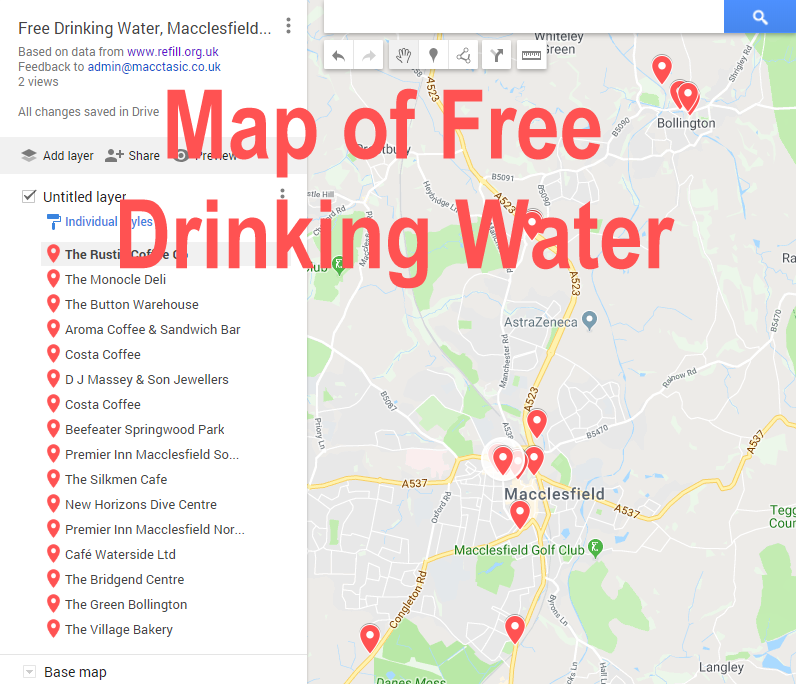 Water
accounts for almost 20% of soft drink bottles sold in the UK.
Water
accounts for almost 20% of soft drink bottles sold in the UK.
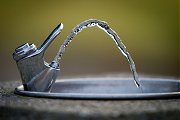
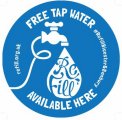
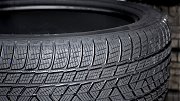 Road Run Off
Road Run Off
When your tyres wear out, you probably don't wonder where the rubber
went.
Sadly, the answer is mostly into roadside soil, or into drains, rivers and
the seas.
Micro-plastics are defined as particles less than 5mm in diameter.
Progressing from left to right, the graph below shows how most micro-plastics (98%) originate on land, rather than the breakdown of larger pieces in the ocean. Land based activity produces :- Road Run Off (66%), Waste Water (25%), and Wind borne dust (7%).
These components take a variety of routes, but ultimately half stays in the soil and half gets into the oceans.
Tyre abrasion is estimated by
Friends of the Earth to be the second
largest source of plastic pollution - after 'Large Plastic Items', and eight times bigger than that from
clothes washing.
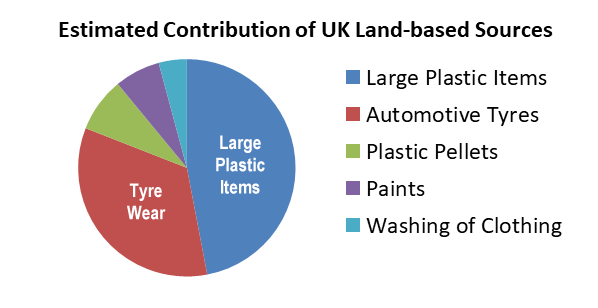
There are some
specially designed roadside gullys now that aim to
collect this material, but the vast majority of existing gullys have
limited capacity, and can be flushed out in heavy rainfalls.
The developed western nations can take some comfort from (relatively) good performance on managing plastic waste, but (compared with developing countries), we are big contributors in road run-off:-
But avoid creating other problems:-
Improve our Recycling?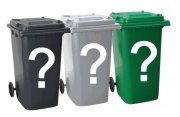
Recycling is more about conserving resources than pollution reduction. Any rubbish put into the local 'Waste Management System' will indeed be managed - with the worst case being landfill. However, since the introduction of the Land Fill Tax of almost £90 per tonne, everyone in the waste management industry is highly motivated to recycle as much as possible.
Increasingly, the worst case is incineration to generate electricity for the national grid. Even then, the resulting ash is sifted for recoverable metals, and the remaining ash is used for road-building.
In Cheshire East only 5% of all rubbish goes to landfill. Overall, recycling has improved from 17% to 56% in a decade.
Residential rubbish from kerbside collection:
Silver bin contents were until recently taken to UPM at Shotton (See process explanation). The site principally recycled newspaper and magazines; other materials including mixed paper and cardboard, were separated and shipped elsewhere for more processing, mostly quite local to Shotton and all within the UK. The sorting process is now done by two companies; Regen, and Biffa Waste.
Black bin contents are sent to Viridor at Runcorn for energy recovery. Take a virtual tour of the plant. Metal is recovered from the ash, and the ash itself is used as road-building material. Viridor have been shortlisted by the government to build a carbon capture system for the plant.
Green Bin strictly garden
waste only, but Cheshire East will has
an in-vessel composter at Crewe, operated by
Wastewise. You
can put food waste,
including compostable cups, plates and
cutlery in the green bin too.
Details .
Previously, food waste made up around 40% of the average
black bin contents.
Rubbish taken to a 'Household Recycling Centre' (formerly 'The Tip') goes a different route, via H W Martin. The staff at these sites encourage visitors to put plastics in the right skip for subsequent sale to a recycler. Our rubbish is divided into an extensive range of recycling categories:- garden waste, general waste, wood, chipboard, white goods, TVs and computers, bicycles, scrap metal, paper, cardboard, batteries, fluorescent lamps, builders' rubble, three separate colours of glass, cooking oil, engine oil, and plastic bottles.
Commercial waste collection is
partly undertaken by the council, and partly by private contractors such
as
Henshaws,
Veolia,
Viridor ,
Fresh Start
and Biffa who all have
their own materials recovery systems.
Waste Cooking Oil from cafes and restaurants is collected by Olleco (seen here at the Wizard Tea Rooms, Alderley Edge.
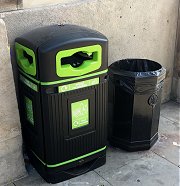 Waste in Litter Bins
is not
currently sorted, but Macclesfield Town Council have introduced recycling
bins in the town centre. Their success will depend on clarity of signage, and goodwill on
the part of the public to separate their deposits.
Waste in Litter Bins
is not
currently sorted, but Macclesfield Town Council have introduced recycling
bins in the town centre. Their success will depend on clarity of signage, and goodwill on
the part of the public to separate their deposits.
Read More
about
Litter Bins
for Recycling
What Can You Do to Help?
The quick rule of thumb is to put only plastic items which you
can crush in your hand into the silver bin; otherwise use the black bin.
Get in Touch with like-minded people:-
Background Information Sources
What about Cleaning up the Oceans?
Feedback Welcome: enquiry@notjustonce.org
This page is privately edited and published by Colin Townend.
